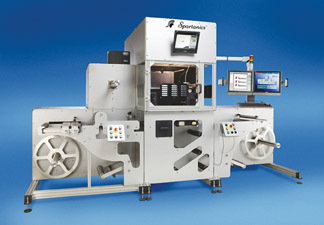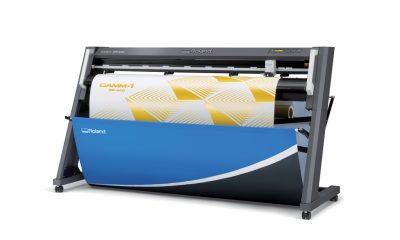Graphics Printing
Published
10 years agoon

Automotive designers are discovering that film insert molding (FIM) now offers much more than the usual dashboard interfaces. Led by the European market, FIM is enabling designers to achieve striking results all around the vehicle that add value, enhance the brand and, ultimately, boost sales.
Automotive designers are discovering that film insert molding (FIM) now offers much more than the usual dashboard interfaces. Led by the European market, FIM is enabling designers to achieve striking results all around the vehicle that add value, enhance the brand and, ultimately, boost sales.
Recent advances in the manufacture of specialty films have enabled designers in many industries to be more adventurous and this is having a marked effect on the automotive market. In Europe, automotive decoration using FIM is more than just a case of producing colored plastic shapes, its capability is also being used to create and enhance brand values, too.
In the U.S., a similar progression is taking place; designers are beginning to see that the kind of specialty films supplied is helping them to add value, and we expect that it won’t be long before designers exploit FIM to create automotive branding in the same way as Europe.
So what’s driving this development? FIM technology can now deliver any color, even metallic and mirror effects, with several projects now being developed in white. FIM can produce more than just a high-gloss finish; you can have textures on the foil and even circuit printing, creating the opportunity to put a single, interactive control surface on the dashboard (Figure 1) instead of panels with cutaways to accommodate the switches.
Designers are now extending the use of FIM with parts such as overhead lighting consoles in the roof, illuminated door rails, and even badges. The potential to enhance brand values with FIM is illustrated by Alfa Romeo with its Giulietta model. Here, FIM has been used to great effect on the music console to make not only a highly attractive panel design, but also a strong statement with the brand name appearing in its only non-badge position on vehicle. The design of this elegant, minimalist console, which becomes even more appealing when the backlit setting is activated, gives a desirable premium look and feel.
In the U.S., the perception of interior automotive fitting as inferior is changing fast as the vogue for a hard silver and chrome look shifts towards a warmer European styling, a moved welcomed by the market (Figure 2). In Asia, there’s great potential for the same type of design-led added value in automotive molding. FIM had huge application in mobile phones, many of which were made in China, but now that mobiles are essentially a glass window in a frame, use of FIM has naturally become limited in this market. However, as this manufacturing base develops in the automotive supply chain and wins OEM confidence, we will see more innovation. In Europe, designers are already using FIM to push OEM specification, and in America, projects are increasingly OEM-led. In Asia, there’s a wonderful opportunity to repeat the same story.
FIM manufacture
The FIM process involves four manufacturing steps: printing, forming, trimming, and molding. But it is critical to choose the correct material for the job and have optimized design criteria for the forming and molding stages.
The first stage is typically screen printing the necessary graphics onto the underside of a special, hardcoated film. The printed sheets are then transferred to a vacuum, pressure, or thermoforming press, where they are formed to the exact shape of the components being made, with the outer side of film effectively becoming the outer side of the finished component. The sheet is trimmed and individual components cut to size, and each is then inserted in a female injection mould cavity, where molten polymer is injected behind the film, bonding the two materials together to create a solid and finished part ready for subsequent product assembly.
The benefits of FIM
In addition to offering a quick and simple method of producing three dimensional components, FIM provides a number of benefits, including the ability to realize complex, high-definition designs and produce durable, textured parts.
As the components can be shaped extremely accurately, with print registration within ±0.2 mm, high-quality designs can be achieved that may not be possible with alternative production methods. In addition, for products such as mobile phones it is possible to integrate the decorated enclosure and the clear display window into a single component, reducing the materials required and, therefore, costs.
Furthermore, by printing the component’s decoration on the underside of the film, the hard-coated substrate used forms a tough, protective skin over the complete surface of the finished part. This makes the component considerably more resistant to scratches and abrasions than those that have been sprayed or have had designs applied to them.
Film selection
Many polymer films are available in different thicknesses and surfaces finishes and with a variety of coatings: protective, decorative, and functional. The film provides a dimensionally stable support for the decorative layer during printing drying and forming stages, an optically clear medium through which the decorative layer can be seen clearly with minimal color distortion, a protective layer between the outside world and the decoration, and an environmental barrier against moisture ingress, gas ingress, etc. The most common polymer substrates are polycarbonate, PC/PBT-blend films, PMMA, and PET.
Film thickness is a key consideration. It is a common misconception that deep-draw parts always require thick film. True, the mechanical integrity of the film will decrease as it is drawn, and a film with a higher initial thickness will be capable of drawing further than a thinner film before it loses so much strength that it cannot retain its shape. However, in a real part, it is not the absolute draw depth that is important, but the draw ratio.
The draw ratio is defined as the film thickness before forming, divided by the film thickness after forming. This ratio will vary over the surface of a form profile. The most critical point is where this ratio reaches a maximum. It is important to understand that this point of maximum draw ratio will not necessarily coincide with the deepest draw.
Another factor that’s not visible on the finished part is the amount of film material available to form the shape required. This is often limited by the amount of material between one form feature and the next, or between a form feature and the clamp of the forming tooling. In reality it is rare to find a draw ratio on a part greater than three. In other words the film rarely forms to less than one third of the original thickness. Where formable, hardcoated films are used, the coating itself will usually fail before this limit is reach in any case.
A typical film for FIM has a thickness between 125-250 μm. When drawn by a factor of three, even the thinnest material still has a thickness of more than 40 μm. This is usually enough to retain mechanical integrity in the pre-form. It is not, therefore, necessary to specify excessive film thicknesses of 375 μm or more. This can provide a large cost saving. Film thickness can be important, however, when it is necessary to hide witness marks from cut-outs in the molding, where tactile dome switches are to be incorporated into the part, or where unsupported windows are required. These are all specialized applications and require great care in part and process design, and such proposals must be approved throughout the supply chain to avoid unforeseen issues.
In general, the structural integrity of the preformed part determines the minimum film thickness you can use. Film materials vary in their rigidity. Polyester film has the highest rigidity and can therefore be used in the thinnest gauges. For some shallow-draw applications, PET films as thin as 50 μm have been used. The remaining materials have broadly similar rigidity and are normally used in thicknesses of 175 or 250 μm. Deep, wet-look effects usually require a thicker film, but 250 μm is normally sufficient to get the required effect.
Printing equipment
Good control of the screen-printing process is essential to ensure reproducibility of print thickness and edge definition. High-quality equipment capable of handling thin, plastic substrates and holding tight registration (±0.2 mm) is essential to ensure success. For most films, manual and automatic presses are acceptable. Cylinder and roll-fed presses must include the ability to remove print-side laminates at the unwind station, as virtually all films are supplied with a protective second-surface laminate. A good starting point for the squeegee is 80 durometer.
Environment
Humidity in process and storage areas for the product should be maintained at below 55% RH. Very low humidity may cause problems with static electricity so an ideal humidity range between 50-55% RH is recommended. This is a tight tolerance. Most FIM applications require a very high level of cosmetic performance. Use of a cleanroom specified and maintained to at least ISO7 standard is highly recommended.
Inks
The inks used for the FIM process should be chosen carefully, as conventional screen-printing inks are not generally formulated to withstand the higher temperatures and mechanical stresses imposed during thermoforming and injection molding. Use inks qualified by the ink supplier for second-surface FIM applications. Most inks are solvent-based, but UV formulations are available. The inks must be processed precisely according to the manufacturer’s recommendations.
Printing onto plastic substrates requires care. Some plastics films are soluble in common ink solvents. This can give good adhesion by allowing the ink molecules to intermingle with the polymer at the interface, but penetration of ink solvent into the bulk film can make the film difficult or impossible to dry thoroughly. If solvent is trapped inside the film, then it can be vaporized during forming or molding with catastrophic effects on cosmetics (bubbles in the film) or adhesion (gross delamination). This is true of PC, PMMA, and even PC/PBT blend films
Long bake cycles are used in FIM processes to prevent such problems, and it is the diffusion time through the film that limits the drying rate. Higher temperatures and high airflows help little once the solvent is deep inside the film. Correct ink and ink-solvent selection is crucial for such films. Too powerful a solvent can even cause stress cracking of the film that might not become visible until long after the part is completed. Too weak a solvent may give insufficient surface etching to allow good adhesion. Ink and film suppliers cooperate well in this market to provide optimal solutions, so it is essential to ensure they are engaged with processors to optimize the performance.
PET film is extremely resistant to solvents. For that reason, it is not susceptible to solvent penetration. Thorough drying is easier on PET, even though it may appear to take longer for the surface to feel dry. This is because solvent can only escape from the film from the top surface and not through the film. High temperatures and high airflows that scour the ink surface during drying ensure good solvent removal because the solvent never gets deeper then that thickness of the ink. This high resistance to solvents is also a huge benefit in the final application as PET films give excellent resistance to common chemicals and reagents.
Unfortunately, the inability of the solvent to penetrate PET means that getting good adhesion is more difficult than it is on more solvent sensitive films. Many people believe that surface energy is a key measure of adhesion. A proper scientific understanding of adhesion reveals that this is not true. Surface energy is important only to provide good wetting. Poor wetting is self-evident, and where it is not achieved, the ink will visibly repel from the surface.
With PET, the film surface is relatively chemically inert and only very aggressive (two-pack curing) systems are able to create chemical bonds. These tend to have limitations in use, such as poor pot life or poor formability, and must be used with care. With more tractable inks we must rely on the interpenetration mechanism. On PET interpenetration can only be achieved using a primer or pre-treat. These are coatings applied during manufacture of the film with complex chemistry and process technology to ensure that the coating is bonded to the PET surface.
Pre-treats are applied during the primary manufacture of the PET film itself. Primers are applied as a separate subsequent coating operation. The primer or pre-treat itself is more open to penetration by the ink solvent than the PET itself so interpenetration of the ink molecules into the pre-treat can occur giving excellent adhesion.
It should be noted that the forces used in adhesion testing of FIM components can be very high. In general, some failure is seen, and it is important to define exactly where the failure is happening. Common failure modes and other problems include:
Pure adhesion failure True adhesion failure where the film surface is left smooth and clean. Pure adhesive failure is normally a symptom of incorrect ink selection, incorrect or missing pre-treat, or very poor drying.
Cohesive failure of the ink The ink splits down the center, leaving a residue on the film. Cohesive failure is normally symptomatic of a high pigment ratio in the ink (especially metallic flake pigments) or poor ink drying.
Delamination failure of the film substrate The film surface pulls away with the ink from the rest of the film. Delamination failure is usually a feature of the film itself. PET can tend to fail in this way under extreme test conditions due to the internal film structure created by crystallization of the polymer during the manufacturing process. This occurs at test forces so high that this failure mode is unlikely to occur in normal use and should not be regarded as a cause for rejection.
Trapped solvents These may weaken the film and create forming problems such as stress cracks or blisters. The solvents may even pass all the way through the film and have undesirable effects on the hard coating.
Mirror inks require special consideration. These inks rely upon a completely flat surface on which to allow the pigment plates to lie in order to create a high-quality mirror effect. FIM films with a smooth second surface must be used. Even on the gloss print surface of gloss/gloss PC films, care is needed to ensure that the print surface is not etched by the ink solvents and that overprinting of the mirror by other inks does not disrupt the mirror effect.
Print deposit
For rapid drying, a lower print deposit is better suited for FIM than a higher deposit. Thinner coatings dry more quickly and give less opportunity for solvent attack on the PC film. However, care should be taken to ensure that coverage is sufficient to prevent pinholes—especially in backlit applications. This is most important when matte-second-surface grades are used, as the rough print surface of these products must be completely flooded. It is usually better to use two or more thin layers of ink than one thicker layer.
Drying
Drying of each layer of ink must take place immediately after printing. Forced hot-air drying (jet drying) drives the solvent efficiently from the ink without skinning the surface, which can trap solvent and make drying more difficult. A typical drying sequence for each print pass is 2 min at 80°C. The volume of air used in the dryer is also very important in preventing skinning. Air volumes and velocities should be as high as can be achieved on the equipment without causing damage to the wet ink surface.
Thorough baking of the inks is normally required after the final print pass in order to achieve the best possible resistance to ink-wash problems during injection molding. Typical conditions are between 60-80°C for 3-6 hr. Racking of sheets is recommended for baking, as this allows maximum opportunity for trapped solvent to escape. It is important, however, to ensure that the hot rack does not directly contact the film, as this may cause localized heating which results in line defects caused by flow in the coating. The film should, therefore, be placed onto a support sheet that will insulate the film from the rack.
Baking rolls of printed product does not allow ink solvents to escape as easily as they can in a racked sheet. Therefore, thorough drying of the prints after the final print cycle is even more important in roll-to-roll printing. With most FIM inks, baking is still required in order to develop the full melt-resistance properties of the print.
Neil Bolding is quality, technical, and marketing manager for MacDermid Autotype.

Subscribe

Magazine
Get the most important news
and business ideas from Screenprinting Magazine.
Most Popular
-

 Art, Ad, or Alchemy1 month ago
Art, Ad, or Alchemy1 month agoF&I Printing Is Everywhere!
-

 Case Studies1 month ago
Case Studies1 month agoHigh-Density Inks Help Specialty Printing Take Center Stage
-

 Andy MacDougall1 month ago
Andy MacDougall1 month agoFunctional and Industrial Printing is EVERYWHERE!
-

 Columns2 weeks ago
Columns2 weeks ago8 Marketing Mistakes Not to Make When Promoting Your Screen Printing Services Online
-

 Editor's Note2 weeks ago
Editor's Note2 weeks agoLivin’ the High Life
-

 Marshall Atkinson2 weeks ago
Marshall Atkinson2 weeks agoHow to Create a Winning Culture in Your Screen-Printing Business
-

 Thomas Trimingham2 months ago
Thomas Trimingham2 months ago“Magic” Marketing for Screen Printing Shops
-

 News & Trends1 month ago
News & Trends1 month agoWhat Are ZALPHAS and How Can You Serve Them in Your Print Business?






